WALTHAMSTOW WEST
| Walthamstow was first inhabited when, sometime before the Norman conquest, parts of Epping Forrest were cleared for the planting of crops. Walthamstow is mentioned in the Domesday Book of 1086, where it is called Wilcumstou. In 1066 the southern part or manor belonged to a Saxon named Waltheof, but he was executed 10 years later for treason. The manor finally came into the possession of a Norman called Ralph de Toni when he married one of Waltheof's daughters. This manor then became known as Walthamstow Tony. One possible explanation of the name Walthamstow is that it was the 'Tow' (Saxon for a fenced off area) of Waltheof. (See also Plaistow). However, this does not tally with the entry in the Domesday Book. |
CONTENTSSee Also pages forWALTHAMSTOW EAST WALTHAMSTOW VILLAGE 2. Art in the Park 3. Roger Ascham 4. The Black Horse 5. Black Horses 6. The Bridge Art Show 7. Butchers Advert. 8. Andrew Carnegie 9. The Copper Mill 10. Thomas Gamuel School Mural 11. Aromatic Garden 12. Our Lady of the Rosary Mosaic 13. Lloyd Park House Crest 14. Lloyd Park Moat 15. William Morris Gallery 16. Norwood House 17. Outdoor Gym 18. "Pagoda Monoform" 19. Lord Palmerston 20. Pump House Museum 21. A V Roe 22. Shern Hall 23. Shiva 24. Sri Katapaka Vinayagar Temple 25. Tramway Offices 26. The Big W 27. Waltham Forest Arms 28. Walthamstow's Lighthouse |
PUT MOUSE OVER  TO READ NAME ~ CLICK FOR PHOTO & EXPLANATION.
TO READ NAME ~ CLICK FOR PHOTO & EXPLANATION.
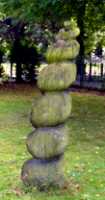 |
"Animus". |
||||||||||||||||||
Aveling Park, beside the bowling green. Wood carving which has weathered and split. According to the psychologist Jung, because all people are regarded as having to some extent both a masculine and a female side in their make-up, "the animus" is regarded as the masculine side of the female personality. (See No. 1. on the MAP) Sculptor: Helen Stylianides Date: 1994 . See also by the same artist "The Guardian" and "Tree of Life". | |||||||||||||||||||
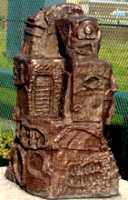 |
Art in The Park. |
||||||||||||||||||
This is one of four bronze sculptures placed along Coppermill Lane as part of a Walthamstow Millennium project fostering Art in The Park. The one pictured was produced by Coppermill Primary School in 2001 and was inspired by the Copper Mill. It is by an entrance to the waterworks almost opposite the mill. Others include one by the visitors car park depicting the reservoirs and bird life and produced by Bancroft Primary school in 2000, and there is another opposite Rensburg Road produced by the Asian Family Group in 2000, depicting the marshes and their wildlife. (See No. 2. on the MAP) | |||||||||||||||||||
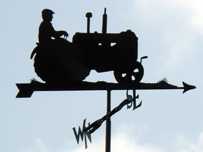 |
Roger Ascham. |
||||||||||||||||||
Billet Road. Weather vane showing a tractor on the roof of Roger Ascham School. Although the vane itself works, the north-south and east-west arms have also rotated and now (2008) are meaningless. The school is appropriately named because Robert Ascham (1515-68) was a classical scholar who for the last 11 years of his life lived in Salisbury Hall Manor which used to be near the present Crooked Billet roundabout. Ascham was tutor to Princess Elizabeth. She later proved to be a credit to him, for as Queen Elizabeth I, she is known to have been proficient in the three classical languages of Latin, Greek and Hebrew. (See No. 3. on the MAP) | |||||||||||||||||||
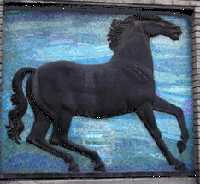 |
The Black Horse. |
||||||||||||||||||
On the exterior wall of Black Horse Road Station. The background to the sculpture is made of mosaic tiles. Some think that the name was originally Black House Road. (See No. 4. on the MAP) Sculptor: David McFall. | |||||||||||||||||||
 |
Black Horses. |
||||||||||||||||||
35 Pretoria Avenue. Flat metal artwork on the front garden Wall. The colour of the animals may well have been chosen because the house is very close to Blackhorse Road. (See No. 5. on the MAP) | |||||||||||||||||||
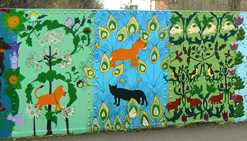 |
The Bridge Art Show. |
||||||||||||||||||
The railway bridge in Pretoria Avenue. This is one of three bridges decorated by the pupils of Stoneydown Park Primary School in 2007. The photo shows part of the work by pupils of year 6. Other paintings can be seen in Suffolk Park Road, Ritchings Avenue and Stoneybridge Avenue. These paintings show considerable artistic skill in the use of colour and design. (See No. 6. on the MAP) | |||||||||||||||||||
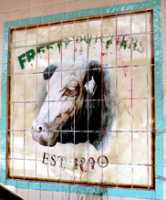 |
Butcher's Advert. |
||||||||||||||||||
On the corner where Mission Grove meets the High Street. The original name of the Butcher has been painted over, but it still states the firm was established in 1890. This shows a tiled picture of a bullock and indicates that this was a high status shopping area, which can also be seen by the architecture further along the High Street. An even older butcher's shop still survives in Walthamstow. (See No. 7. on the MAP) | |||||||||||||||||||
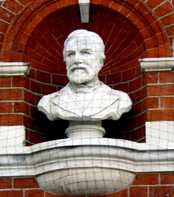 |
Andrew Carnegie. |
||||||||||||||||||
On the front of the Central Library building in High Street. In about 1906, Andrew Carnegie (1835-1919) donated money for a large house to be converted into an important public library by adding a new frontage to the building. This was just one of his many philanthropic projects. Carnegie was born in Scotland but the family moved to the USA, where the young boy gradually worked his way up to management in the American railways. Then he left to form his own steel company, where he made his fortune, becoming the richest man in the world. He then retired and spent the rest of his life giving away his wealth. He was particularly interested in providing free libraries to educate the poor. There is another bust of him on the Manor Park Library (See No. 8. on the MAP) | |||||||||||||||||||
 |
The Copper Mill. | ||||||||||||||||||
Coppermill Lane. This mill was erected c. 1806 and used the water power to roll out sheets from which copper tokens were pressed out. These tokens were used locally instead of coins of the realm. There has probably been a mill of one sort or another on this site from the before the Domesday book of 1086. The earliest mills were water-driven. In the middle ages, main east-west track from Walthamstow village led down the present Church Lane, St Mary's Avenue to Coppermill Lane to the mill, which was on a mill stream diverted from the river Lee. (See No. 9. on the MAP) | |||||||||||||||||||
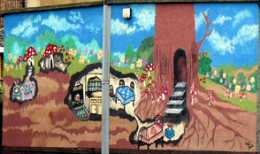 |
Thomas Gamuel School Mural. |
||||||||||||||||||
Chelmsford Road. This depicts a number of presumably elfin underground homes beneath mushrooms and trees. Of particular note is the one equipped with television. Though it is doubtful that reception would be very good without an outside aerial. (See No. 10. on the MAP) Artist: Kali, Date: 2002. | |||||||||||||||||||
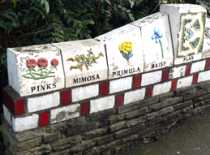 |
Aromatic Garden. |
||||||||||||||||||
Lloyd Park of Forest Road. There is a section of the park set aside for the visibly impaired, where all the plants in it have been chosen for their smell. The entrance is brightly coloured with ceramics and painted bricks. The one on the extreme right of the photo shows a plan of the garden. (See No. 11. on the MAP) | |||||||||||||||||||
 |
Our Lady of the Rosary & St Patrick. |
||||||||||||||||||
On the corner of Southcote Road and Blackhorse Road. This brightly coloured mosaic with its gold tiles seems to glow with light. (See No. 12. on the MAP) | |||||||||||||||||||
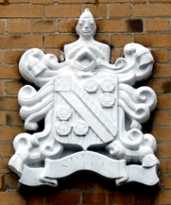 |
Lloyd Park House Crest. |
||||||||||||||||||
On the corner of Forest Road and Winns Terrace. The figure at the top appears to be a racing driver wearing a crash helmet and gripping a steering wheel. On the shield are the four wheels plus two spares. However, this is just fancy. In reality, the figure is a mediaeval knight and the six wheels are indeed roses. The coat of arms is that of the Warner family as the building was erected by them, Winns Terrace is named after the old moated house (see next item), which went by various names including Whinnes Capp. Whynnes and The Winns. (See No. 13. on the MAP) | |||||||||||||||||||
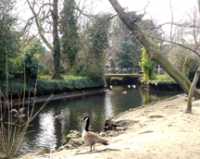 |
Lloyd Park Moat. |
||||||||||||||||||
Lloyd Park entry from Forest Road. The park has a large pond around a central island. There is usually a fine collection of water fowl here. The water feature may well be the oldest man-made feature in Walthamstow. For it is thought to have been constructed as a moat surrounding a mediaeval house called at one time "Cricklewoods" and therefore may date back to the 14th century. The William Morris Gallery occupies a later house built about 1740 and was called Water House because of the old moat that was already in its back garden. The park is named after Edward Lloyd, a publisher of newspapers, who lived there from 1857 when Morris moved out. The park was opened in 1900 after Lloyd donated the house and gardens to Walthamstow council. (See No. 14. on the MAP) | |||||||||||||||||||
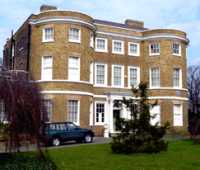 |
William Morris Gallery. |
||||||||||||||||||
Forest Road. This gallery containing examples of Morris's fabric, wallpaper, carpet and furniture designs, and entry is free. William Morris lived here from 1848 to 1856. It was originally known as Water House, because of the lake which fills much of the garden. The garden now known as Lloyd Park, is also open to the public and there is always a rich variety of water fowl there. William Morris (1834-1896) was an influential artist and writer who founded the Arts and Crafts movement in Britain. He was part of the Pre-Raphaelite Brotherhood. His socialist views and his dissatisfaction with factory produced designs led him to gather together a band of craftsmen to produce handmade furniture and furnishings. The bust of Morris which is now in the hallway of the Museum originally stood in Walthamstow Library, where it was unveiled by his fellow Pre-Raphaelite, the painter William Holman Hunt. (See also on Edward Ashbee who was influenced by him) (See No. 15. on the MAP) | |||||||||||||||||||
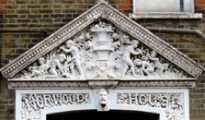 |
Norwood House. |
||||||||||||||||||
15 Cleveland Park Avenue on the corner with Hatherley Road. This house was built in 1895 by Mr Norwood who was a butcher in Walthamstow who also was a property developer. As he was apparently a flamboyant character, could the head over the doorway be a portrait sculpture of him? (See No. 16. on the MAP) | |||||||||||||||||||
 |
Outdoor Gym. |
||||||||||||||||||
Higham Hill Park Recreation Ground, between Hecham Close and Worcester Road. There are eight exercise machines permanently fixed and open for free public use. The three shown in the photo are for Rowing, Back pull and Leg curl/extension. (See No. 17. on the MAP) | |||||||||||||||||||
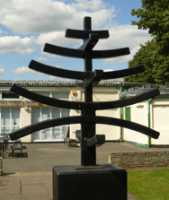 |
"Pagoda Monoform". |
||||||||||||||||||
Aveling Park, between Cafe and tennis courts. This work in metal is one of a number by the same artist which were inspired by eastern art. (See No. 18. on the MAP) Sculptor: Jack Gardner, Date: 1991 . See also by the same artist "Tao Column" and "Lotus" | |||||||||||||||||||
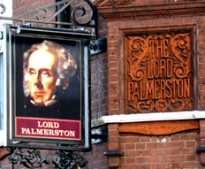 |
Lord Palmerston. |
||||||||||||||||||
On the corner of Forest Road and Palmerston Road. Lord Palmerston (1784-1865) was prime minister from 1855-1858 and from 1859-1865, but is probably better known for his long period as Foreign Secretary. He followed an interventionist policy and was the inventor of gunboat diplomacy. His actions were regarded by some as abrasive, and as a result was sometimes referred to as Lord Pumice Stone. He started his political life as a Tory, but eventually founded the Liberal Party. There is a statue of him in Parliament Square. (See No. 19. on the MAP) | |||||||||||||||||||
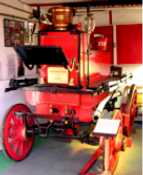
| Pump House Museum. |
||||||||||||||||||
10 South Access Road. This museum is based round the Low Hall Sewage Pump House of 1895. Beside the pump house itself there are number of exhibits connected with public transport - Buses of various shapes and sizes, railway and underground carriages and a German tram. This horse-drawn fire engine, dating from 1865, used to be Leyton's only fire protection. The water was pumped by the muscle-power of the firemen, who manipulated long wooden bars on either side. moving them up and down to make a rocking motion which worked the pump. To see how this was done, HOLD THE MOUSE OVER THE PICTURE. (See No. 20. on the MAP) |
|||||||||||||||||||
Avro 1. | |||||||||||||||||||
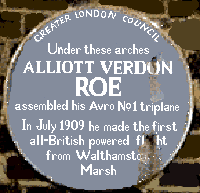 |
A V Roe, Aviation Pioneer. | ||||||||||||||||||
Blue plaque on a railway arch in the Lee Valley Park. To find it go to the Lee Valley Ice Centre, Lee Bridge Road. Between the Centre and the car park an unmade road goes north beside the river Lee. Follow this to a railway bridge. The plaque is between the 4th and 5th arches to the right. A V Roe (1877 - 1970) built and flew the first all-British aircraft. It was powered by a 9 HP JAP engine made in Tottenham. Roe rented two of these arches. He lived in one and built his triplane in the other. It was officially called Avro 1, but was known by many as "The Yellow Terror". Roe went on to found the Avro Aircraft Co. which built among others the Anson, a widely used transport aircraft and the Lancaster which was the mainstay of RAF bomber command in World War II. This arch marks the beginning of an important part of the British aircraft industry. The first flight, which was on July 13th 1909, probably took off from the green marshy area beside the unmade road you have just walked down. (See No. 21. on the MAP) | |||||||||||||||||||
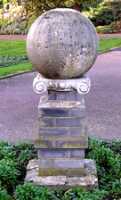 |
Shern Hall. | ||||||||||||||||||
Lloyd Park behind the William Morris Museum. Capital from the old Shern Hall. Shern Hall was an old manor house in the neighbourhood of the present Shernhall Street, which was demolished in 1896. In 1213 King John stayed there and in the 19th Century Cardinal Wiseman lived there before he moved to Etloe House. (See No. 22. on the MAP) | |||||||||||||||||||
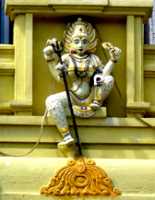 |
Shiva. |
||||||||||||||||||
Shree Marupuram Maha Pathrakali Amnan Kovil Hindu Temple, 271 Forest Road. The main figure over the entrance is that of Shiva who is often portrayed as a white-skinned, semi-female figure holding a trident. The three prongs of which symbolise the three most important Hindu gods � Brahma, Vishnu and Shiva. Brahma is the creator of the universe, Vishnu is its preserver and Shiva is the destroyer of evil. He also plays a positive role by being involved both with the dance and human reproductive powers. (See No. 23. on the MAP) | |||||||||||||||||||
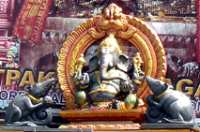 |
Sri Katapaka Vinayagar Temple | ||||||||||||||||||
Bedford Road. The elephant-headed figure on the front of the Temple is Ganesha or Ganapati Vinayaka which is spelled here Katapaka Vinayagar. Ganesha, a widely revered God, is popular as he is regarded as the remover of obstacles, the patron of education, knowledge and wisdom in both science and the fine arts. He was born with a normal head but legends give various accounts as to how it was replaced with that of an elephant. He is often depicted with a rat or a mouse which he used to dominate and ride upon. These animals were seen as pests and his domination illustrates his role as the remover of obstacles. (See No. 24. on the MAP) | |||||||||||||||||||
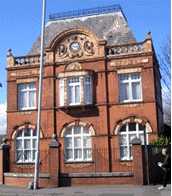 |
Tramway Offices. |
||||||||||||||||||
Chingford Road. By the 1880s there was a service of horse-drawn trams running along Leigh Bridge Road. In 1905, a mechanised tram service linked Stratford and Walthamstow. (See No. 25. on the MAP) | |||||||||||||||||||
 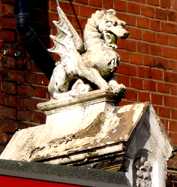 |
The Big W. |
||||||||||||||||||
Above a number of shops at the west end of the High Street. The W is the initial of Thomas Courtenay Warner who developed this part of Walthamstow at the end of the 19th century. The style of the houses was often flamboyantly ornate, as can be seen in Warner Road, which was named after him. Warner was mayor of Walthamstow and an MP. (See No. 26. on the MAP) | |||||||||||||||||||
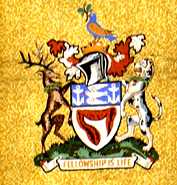 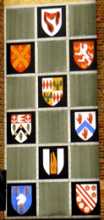 |
Waltham Forest Arms. |
||||||||||||||||||
|
On the corner of Church Hill Lane. The crest is a mosaic. And the motto underneath is Fellowship is Life and comes from a work by William Morris. Another version of this coat of arms, which is carved in stone, can be seen round the corner on the front of the Energy Centre in Church Hill Lane. Beneath this coat of arms are nine smaller ones which belonged to:
|
|||||||||||||||||||
 |
Walthamstow's Lighthouse. |
||||||||||||||||||
120 Markhouse Road, on the corner of and Downsfield Road. This is the Lighthouse Methodist Church and dates from 1893. There is a lantern at the top of the tower, which also contains a spiral staircase. The church was erected because of the generosity of Captain David King of the shipbuilding firm of Bullard King & Co which also ran the Natal Direct Shipping Line, which ran ships direct from London to Durban without stopping at the Cape. Although the lighthouse may be connected to this benefactor, it may also have been chosen because the church saw it's teachings as a light in a dark world. There are several other Methodist churches which use the same analogy. See also a real lighthouse in East London and a church that used to guide ships. (See No. 28. on the MAP) | |||||||||||||||||||
OTHER AREAS COVERED:-
|| Beckton || Bethnal Green || Blackwall || Bow || Bromley-by-Bow || Canary Wharf || Canning Town || Chingford || Cubit Town || Custom House || East Ham || East India Dock || Forest Gate || Higham's Park || Leyton || Leytonstone || Limehouse || Little Ilford || Manor Park || Mile End || Millwall || North Woolwich || Plaistow || Plashet || Poplar || St George's || St Katharine Dock || Shadwell || Shoreditch || Silvertown || Snaresbrook || Spitalfields || Stepney || Stratford || Upton || Walthamstow East || Walthamstow Village || Walthamstow West || Wanstead || Wapping || West India Dock || Whitechapel || Woodford || |